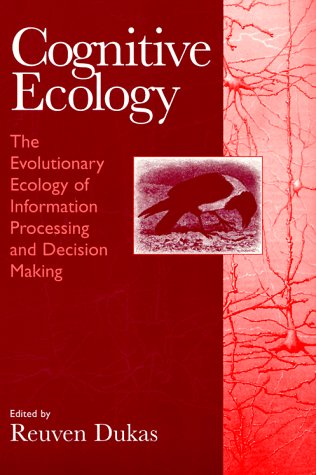 BACK COVER AND ENDORSEMENTS:
BACK COVER AND ENDORSEMENTS: HOME | Lab members | Research projects | Prospective students | Publications | Cognitive Ecology | e-mail | Links
COGNITIVE ECOLOGY
The Evolutionary Ecology of
Information Processing and Decision Making
Edited by Reuven Dukas
1998
The University of Chicago Press
CONTENTS:
1. Introduction
Reuven Dukas
1.1 Definition and goals
1.2 Background
1.3 Why study cognitive ecology?
1.4 The cognitive system
1.5 Preview
2. Neural representation and the evolution
of signal form
Magnus Enquist and Anthony Arak
2.1 Introduction
2.2 Common qualities of signal form
2.3 The problem of recognition
2.4 Evidence for receiver bias
2.5 Neural representation and recognition of signals
2.6 Coevolution of signals and receiver mechanisms
2.7 Conflicts of interest and the evolution of signals
2.8 Implications for strategic models of signaling
2.9 Evolutionary aesthetics - did darwin get it right?
2.10 Conclusions
2.11 Summary
3. Constraints on information
processing and their effects on behavior
Reuven Dukas
3.1 Introduction
3.2 Constraints: definition and biological foundations
3.3 Attention
3.4 Sustained vigilance
3.5 Memory
3.6 Conclusions and future directions
3.7 Summary
4. Evolutionary ecology of learning
Reuven Dukas
4.1 Introduction
4.2 Phenotypic plasticity
4.3 Learning as a type of phenotypic plasticity
4.4 Ecological factors favoring the evolution of
learning
4.5 Fitness components, life history, and learning
4.6 Learning about learning: conclusions and prospects
4.7 Summary
5. The cognitive ecology of song
communication and song learning in the song sparrow
Michael D. Beecher, S. Elizabeth Campbell & J. Cully Nordby
5.1. Introduction
5.2. Background
5.3. Song Learning
5.4. Communication by Song in Male-Male Interactions
5.5. Discussion
5.6. Summary
6. Cognitive ecology of navigation
Fred Dyer
6.1 Introduction
6.2 Diversity in the problem of goal orientation
6.3 Currencies and constraints
6.4 Case studies
6.5 Conclusions
6.6 Summary
7. The Ecology and neurobiology of
spatial memory
David .F. Sherry
7.1 Introduction
7.2 The behavioral ecology of spatial memory
7.3 Memory and spatial orientation
7.4 The neurobiology of spatial memory
7.5 Conclusions
7.6 Summary
8. Risk-sensitive foraging: decision-making
in variable environments.
Melissa Bateson and Alex Kacelnik
8.1 Introduction
8.2 Functional explanation 1: long-term rate
maximization
8.3 Functional explanation 2: risk-sensitive foraging
theory
8.4 Functional explanation 3: time discounting
8.5 Mechanistic explanation 1: short-term rate
maximizing
8.6 Mechanistic explanation 2: perceptual error
8.7 Conclusions
8.8 Summary
9. Behavioral decisions about foraging and
predator avoidance
Ronald C. Ydenberg
9.1 Introduction
9.2 Foraging theory
9.3 Foraging and information
9.4 Foraging under the risk of predation
9.5 Conclusions
9.6 Summary
10. Evolutionary ecology of partner
choice
Lee
A. Dugatkin & Andrew Sih
10.1. Introduction
10.2. What is partner choice?
10.3. Examples of partner choice
10.4. Types of partner choice
10.5. Atomistic approaches to the study of partner
choice
10.6. The costs and benefits of partner choice
10.7. Cognitive ecology and partner choice
10.8. Summary
11. Cognitive ecology: prospects
Reuven Dukas
11.1 Neurons and behavior
11.2 Constraints
11.3 Computation
11.4 The natural environment
11.5 How do brains work?
![]()